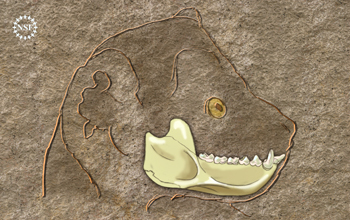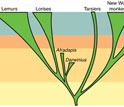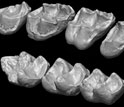News Release 09-205
Ancient Lemurs Take Bite Out of Evolutionary Tree
The fossil primate Darwinius and a new find, Afradapis, are not related to humans

Artist's reconstruction of lower jaw of 37 million-year-old Egyptian primate, Afradapis.
October 21, 2009
View a video featuring Stony Brook University paleontologist, Erik Seiffert.
This material is available primarily for archival purposes. Telephone numbers or other contact information may be out of date; please see current contact information at media contacts.
About 40 miles outside Cairo, Egypt, National Science Foundation (NSF)-supported paleontologists from three American universities are revealing features of a newly discovered African primate and solving a riddle about humankind's evolutionary past.
Lead researcher Erik Seiffert of New York's Stony Brook University and his colleagues say their find has the potential to clear up a portion of the human evolutionary tree by resolving the location of a misplaced species.
"The recently described fossil Darwinius, originally recovered from a disused quarry near Messel, Germany in the 1980s, has been widely publicized as an important 'link' in the lineage to higher primates," said Seiffert. He and his research team recently discovered a lemur-like relative of Darwinius in Africa that they named Afradapis and analyzed its place in primate evolution.
"Our study results indicate that Darwinius and its now extinct relatives, including Afradapis, are not in the evolutionary lineage leading to monkeys, apes, and humans as has been debated," he said. "Instead they are more closely related to the living lemurs and lorises."
They report the finding in the October 20 issue of the journal Nature. NSF supports the research through its social, behavioral and economic sciences directorate's physical anthropology program.
Seiffert's team, which includes Jonathan M. G. Perry of Midwestern University, Ill; Elwyn L. Simons of Duke University, N.C. and Doug M. Boyer also of Stony Brook, base their findings on analysis of Afradapis fossils collected from an excavation site modestly called BQ-2 near the Fayum Depression in northern Egypt.
They first discovered a poorly-preserved Afradapis fossil, a fragment that showed features of the front teeth and jaw bone that were almost identical to those of later Old World monkeys. But it didn't make sense to the researchers that a member of that primate lineage would have been present in Africa at such an early time period, about 37 million years ago.
Soon they recovered additional Afradapis fossils and through dental analysis eventually clarified that Afradapis and Darwinius weren't in the line of Old World monkeys, apes and humans, but had concurrently evolved similar features with their distant relative, a type of anthropoid.
"The similar features evolved through the process of convergent evolution," Seiffert explained. "This means that under similar selection pressures, both lineages came to have similar specializations, but these features were not present in their last common ancestor."
Noted shared specializations from dental examinations include fusion of the two halves of the jaw, reduction and loss of the first few premolar teeth, and the presence of front incisors that are each shaped like a spatula, rather than being shaped more like a cone.
Interestingly, the ancestors of Old World monkeys, apes, and humans developed these features millions of years later, long after Afradapis and Darwinius were extinct. But, reconstructing the most likely family tree of both living and extinct primates, taking into consideration virtually all available anatomical evidence, the paleontologists determined that Darwinius, and its relative Afradapis, are not in the direct evolutionary line with humans.
"Our discoveries certainly contribute to a growing body of evidence that indicates that convergent evolution was a common phenomenon in early primate evolution," Seiffert said.
-NSF-
-
View Video
Erik Seiffert explains where ancient lemurs place on the primate evolution tree.
Credit and Larger Version -
Sifaka Lemur in Madagascar.
Credit and Larger Version -
Proposed placement of Afradapis and Darwinius on the primate family tree.
Credit and Larger Version -
Studies of upper and lower molars of extinct Afradapis primates show convergent evolution.
Credit and Larger Version -
Palentologist Erik Seiffert excavates a new location in northern Egypt's Fayum Depression.
Credit and Larger Version
Media Contacts
Bobbie Mixon, NSF, (703) 292-8485, email: bmixon@nsf.gov
Program Contacts
Kaye Reed, NSF, (703) 292-7850, email: kreed@nsf.gov
Elizabeth Tran, NSF, (703) 292-5338, email: etran@nsf.gov
Principal Investigators
Erik Seiffert, Stony Brook University, (631) 444-6945, email: erik.seiffert@stonybrook.edu
The U.S. National Science Foundation propels the nation forward by advancing fundamental research in all fields of science and engineering. NSF supports research and people by providing facilities, instruments and funding to support their ingenuity and sustain the U.S. as a global leader in research and innovation. With a fiscal year 2023 budget of $9.5 billion, NSF funds reach all 50 states through grants to nearly 2,000 colleges, universities and institutions. Each year, NSF receives more than 40,000 competitive proposals and makes about 11,000 new awards. Those awards include support for cooperative research with industry, Arctic and Antarctic research and operations, and U.S. participation in international scientific efforts.
Connect with us online
NSF website: nsf.gov
NSF News: nsf.gov/news
For News Media: nsf.gov/news/newsroom
Statistics: nsf.gov/statistics/
Awards database: nsf.gov/awardsearch/
Follow us on social
Twitter: twitter.com/NSF
Facebook: facebook.com/US.NSF
Instagram: instagram.com/nsfgov







